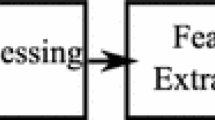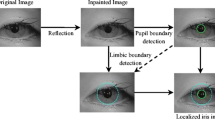Abstract
Iris recognition in the presence of eyelash occlusions is a challenging task over the years since it has begun. The active area captured under non-ideal imaging conditions usually suffers from low contrast, poor brightness, blur due to camera or subject’s relative motion and particularly eyelash and eyelid occlusions. Accurate segmentation methods avoid occlusions to some extent but not completely always. In the proposed method, pixel-wise texture synthesis is done on occluded regions which improves the correct recognition rate (CRR). The contourlet transform which is a multiresolution tool, decomposes an image into different scales and directions with the help of pyramidal and directional filter bank (PDFB). A new FIR filter named as SSK filter is proposed by the authors for the PDFB in contourlets to extract apt features of iris such that the CRR is further improved. The performance of the proposed method is checked against CASIA-Iris-Interval (V3), IITD, CASIA-V1 and UBIRIS-V1 iris databases, and from the results obtained, it is proved that the proposed method is very much worthwhile for improved iris recognition even in the presence of eyelash and eyelid occlusions.





Similar content being viewed by others
References
Bowyer KW, Hollingsworth K, Flynn PJ (2008) Image understanding for iris biometrics: a survey. Comput Vis Image Underst 10:281–307
CASIA-I and Interval Databases. http://biometrics.idealtest.org/dbDetailForUser.do?id=1
Chi C-Y, Chiou S-L (1992) A new WLS Chebyshev approximation method for the design of FIR digital filters with arbitrary complex frequency response. Signal Process 29(3):335–347
Daugman JG (2003) Demodulation by complex-valued wavelets for stochastic pattern recognition. Int J Wavelets Multiresolut Inf Process 1(1):1–17
Daugman JG (2004) How iris recognition works. IEEE Trans Circuits Syst Video Technol 14:21
Daugman JG (2007) New methods in iris recognition. IEEE Trans Syst Man Cybern 37:1165–1175
Do MN, Vetterli M (2005) The contourlet transform: an efficient directional multiresolution image representation. IEEE Trans Image Process 14:2091–2106
Efros AA, Leung TK (1999) Texture synthesis by non-parametric sampling. Int Conf Comput Vis 2:1033–1038
Elgamal M, Al-Biqami N (2013) An efficient feature extraction method for iris recognition based on wavelet transformation. Int J Comput Inf Technol 2:521527
Eskandari M, Toygar O, Damirel H (2013) A new approach for face-iris multimodal biometric recognition using score fusion. Int J Pattern Recogn Artif Intell 27(3):1356004
IITD Database. http://www4.comp.polyu.edu.hk/~csajaykr/IITD/Database_Iris.htm
Kidambi S (1997) Computationally efficient weighted least squares design of FIR filters satisfying prescribed magnitude and phase specifications. Signal Process 60:127–130
Kong W, Zhang D (2001) Accurate iris segmentation based on novel reflection and eyelash detection model. In: Proceedings of international symposium on intelligent multimedia, video and speech processing, Hong Kong
Lim S, Lee K, Byeon O, Kim T (2001) Efficient iris recognition through improvement of feature vector and classifier. IEEE Trans Image Process 23:61–70
Ma L, Wang Y, Tan T (2002) Iris recognition based on multichannel gabor filtering. Proc Fifth Asian Conf Comput Vis 1:279–283
Ma L, Wang Y, Tan T (2002) Iris recognition using circular symmetric filters. In: Proceedings of 16th IEEE international conference on pattern recognition, Quebec
Ma L, Tan T, Wang Y, Zhang D (2004) Efficient iris recognition by charaterizing key local variations. IEEE Trans Image Process 13(6):739–750
Makthal S, Ross A (2005) A synthesis of iris images using Markov random fields. In: 13th European signal processing conference (EUSIPCO), Antalya, Turkey
Masek L (2003) Recognition of human iris patterns for biometric identification. Thesis, University of Western Australia. http://www.peterkovesi.com/studentprojects/libor/LiborMasekThesis.pdf
Munemoto T, Li YH, Savvides M (2008) Hallucinating irises—dealing with partial and occluded iris regions. In: 2nd IEEE international conference on biometrics: theory, applications and systems, Arlington, VA, pp 1–6
OSUSVM. http://kaz.dl.sourceforge.net/project/svm/svm/3.00/osusvm-3.0.zip
Phoong SM, Kim CW, Vaidyanathan PP, Ansari R (1995) A new class of two-channel biorthogonal filter banks and wavelet bases. IEEE Trans Signal Process 43(3):649661
Rahulkar AD, Holambe RS (2012) Half-iris fature extraction and recognition using a new class of biorthogonal triplet half-band filter bank and flexible k-out-of-n: a postclassifier. IEEE Trans Inf Forens Secur 7(1):230–240
Roy K, Bhattacharya P, Suen CY (2010) Towards nonideal iris recognition based on levelset method, genetic algorithms and adaptive asymmetrical SVMs. Eng Appl Artif Intell 24:458–475
Suvarchala PVL, Srinivas Kumar S, Chandra Mohan B (2013) Iris recognition under non-ideal imaging conditions and CCD noise. In: PReMI-2013, LNCS 8251, Springer, Berlin, pp 319–326
UBIRIS Iris Database. http://iris.di.ubi.pt
Umer S, Chandra Dhara B, Chanda B (2016) Texture code matrix-based multi-instance iris recognition. Pattern Anal Appl 19(1):283295
Vaidyanathan PP, Nguyen TQ (1987) A trick for the design of FIR half-band filters. IEEE Trans Circuits Syst 34(3):297–300
WVU Iris Database. http://www.csee.wvu.edu/~xinl/demo/nonideal_iris.html
Yang G, Fang X, Jing M, Zhan S, Hou M (2010) Contourlet filter design based on Chebyshev best uniform approximation. EURASIP J Adv Signal Process 2010:33
Zhang D, Monro DM, Rakshit S (2006) Eyelash removal method for human iris recognition. IEEE international conference on image processing, pp 285–288
Zhou Y, Kumar A (2010) Personal identification from iris images using localized radon transform. In: Proceedings of 20th IEEE international conference on pattern recognition (ICPR), pp 2840–2843
Acknowledgements
Special thanks to Dr. B. Chandra Mohan, Professor and Head, Department of Electronics and Communication Engineering, BEC, Baptla, AP, India, for his support while carrying the experiments.
Author information
Authors and Affiliations
Corresponding author
Rights and permissions
About this article
Cite this article
Suvarchala, P.V.L., Srinivas Kumar, S. Texture synthesis and modified filter bank in contourlets for improved iris recognition. Pattern Anal Applic 21, 1127–1138 (2018). https://doi.org/10.1007/s10044-018-0700-9
Received:
Accepted:
Published:
Issue Date:
DOI: https://doi.org/10.1007/s10044-018-0700-9




